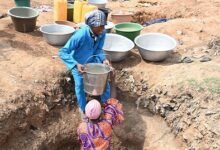
An estimated GH¢1.6bn agricultural livelihoods were lost due to the Akosombo/ Kpong dams spillage that affected eight districts in the Greater Accra, Eastern and Volta regions in September and October last year.
This represents an estimated 1.2 per cent in Gross Domestic Product of Ghana, a Consultant at the Food and Agriculture Organisation (FAO) of the United Nations, Stephen Frimpong, disclosed last Friday at an expert review recovery and rehabilitation planning workshop at Sogakope in the Volta Region.

Officials of the FAO, Ministry of Food and Agriculture (MoFA), district directors of the MoFA, officials of NADMO and Ghana Statistical Service participated in the workshop.
It was to appraise the impact of the floods on agriculture and direct agriculture livelihoods in the downstream communities of eight districts- Ada East, Lower Manya, Asuogyaman, North Tongu, Central Tongu, South Tongu, Shai Osu Doku and Anloga following the spillage.
This spillage caused direct damages to crops, livestock, forestry, aquaculture and fisheries of the people in the downstream communities.
In the wake of the spillage that displaced estimated 48,000 people, the FAO in collaboration with the National Disaster Management Organisation (NADMO) and other agencies are ascertaining the flood’s direct damages to agriculture livelihoods, and develop response and rehabilitation plan for the affected communities.
Data was collected from 63 per cent (117 out 184) affected communities by NADMO, MoFA and other officials last month for the assessment of the impact of the floods.
The consultant explained that the “FAO Methodology for Damage and Loss in Agriculture Assessment” tool was used in the exercise.
Mr Frimpong said several dam spillage had occurred over the years displacing thousands of people and destroying agriculture livelihood, adding that with climate change, “the floods that occurred in Ghana is not one-time thing, and we will probably get more floods in the country”.
The FAO Consultant said because of climate change, floods were intensifying, affecting estimated 96 per cent of the global population, with annual damages to infrastructure and livelihoods estimated at $13.7bn.
The Assistant FAO Representative in Ghana and Head of Programmes, Benjamin Adjei, said the only option was rehabilitation or recovery, adding, “Recovery must be informed by data, knowing what exactly was damaged and how much investment is needed in where and for which people.”
“Indeed, in times like this, the victims need us and the best we can do to understand their sufferings better and needs is by listening to them through these assessments, the results of the findings which we are here to review and better contextualised,” he said.
“Here, we are looking at direct impact to agricultural livelihoods related to crops, livestock, forestry, fisheries and aquaculture. It is in light of this – working together with all of you – this workshop provides us the platform to brainstorm on the assessment of the impact of the floods on the agricultural livelihoods and what can be done or how best to shape what is being done currently,” he added.
“I take this opportunity to thank all districts, your staff, NADMO and Department of Agriculture – for making available your expertise, time and ecological knowledge of the communities affected in support of the data collection in March of this year. Your supports to this exercise tremendously helped to better understand the impact of the floods on agricultural livelihoods.”
FROM ALHAJI SALIFU ABDUL-RAHAMAN, SOGAKOPE






